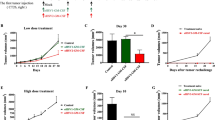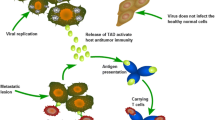Abstract
The aim of this study is to observe the in vitro-targeted destruction of lung adenocarcinoma using recombinant Type I herpes simplex virus (HSV-I)-mediated gibbon ape leukemia virus envelope glycoprotein (GALV.fus), controlled by UL38 promoter and cytomegalovirus promoter (CMVP). A recombinant HSV-I plasmid encoding the GALV.fus was transfected into green monkey kidney cells, the lung adenocarcinoma line A549, and the human fetal fibroblast cell line HFL-I GNHu5 in various doses. The effects and expression of in vitro GALV.fus were observed using an inverted microscope. Enhanced green fluorescence protein expression served as the contro1 for GALV.fus. Recombinant HSV-I virus was produced. Fusogenic recombinant virus infection led to cell fusions in A549 in a dose-dependent manner. Nonfusogenic viruses only produced conventional cytotoxic effects. Recombinant HSV-I with the CMVP initiated cell fusions in HFL-1 GNHu5 cells with arrested cell cycles or as quiescence. HSV-I regulated by UL38p caused cell fusion only in growing cells. Protein expression of GALV.fus was confirmed by Western Blot in infected A549 and HFL-1 GNHu5. Delivery and tumor-specific expression of GALV.fus gene can selectively and safely target lung cancer in vitro, and may prove to be a novel gene therapy for lung cancer.



Similar content being viewed by others
References
Kamlah, F., Eul, B. G., Li, S., Lang, N., Marsh, L. M., Seeger, W., et al. (2009). Intravenous injection of siRNA directed against hypoxia-inducible factors prolongs survival in a lewis lung carcinoma cancer model. Cancer Gene therapy, 16, 195–205.
Qi, R., Ma, Y., & Liu, Z. (2007). The Pro206Pro and Gln632Gln polymorphisms in DNA repair gene XRCC1 and genetic susceptibility to lung cancer in the Chinese population. Chinese Journal of Clinical Oncology, 34, 4.
Nakamori, M., Fu, X., Pettaway, C. A., & Zhang, X. (2004). Potent antitumor activity after systemic delivery of a doubly fusogenic oncolytic herpes simplex virus against metastatic prostate cancer. The Prostate, 60, 53–60. 2004.
Fu, X., Tao, L., Li, M., Fisher, W. E., & Zhang, X. (2006). Effective treatment of pancreatic cancer xenografts with a conditionally replicating virus derived from type 2 herpes simplex virus. Clinical Cancer Research, 12, 3152–3157. 2006.
Burton, E. A., Wechuck, J. B., Wendell, S. K., Goins, W. F., Fink, D. J., & Glorioso, J. C. (2001). Multiple applications for replication-defective herpes simplex virus vectors. Stem Cells, 19, 358–377. 2001.
Tan, L., Jia, H., Liu, R., Wu, J., Han, H., Zuo, Y., et al. (2009). Inhibition of NF-kappaB in fusogenic membrane glycoprotein causing HL-60 cell death: implications for acute myeloid leukemia. Cancer Letters, 273, 114–121. 2009.
Ji, K., Wang, X., & Xu, A. (2008). Targeting expression of TAT-EGFP driven by the prostate specific antigen promoter. Journal of Shandong University: Health Sciences, 46, 5.
Jones, C., Inman, M., Peng, W., Henderson, G., Doster, A., Perng, G. C., et al. (2005). The herpes simplex virus type 1 locus that encodes the latency-associated transcript enhances the frequency of encephalitis in male BALB/c mice. Journal of virology, 79, 14465–14469.
Martin, E. T., Koelle, D. M., Byrd, B., Huang, M. L., Vieira, J., Corey, L., et al. (2006). Sequence-based methods for identifying epidemiologically linked herpes simplex virus type 2 strains. Journal of Clinical Microbiology, 44, 2541–2546.
Javanmoghadam-Kamrani, S., & Keyomarsi, K. (2008). Synchronization of the cell cycle using lovastatin. Cell Cycle, 15, 7.
Acknowledgments
This study was supported by the National Natural Sciences Foundation of China (Grant No. 30471984) , the Foundation of Bureau of Public Health of Chongqing (Grants 06-2-001 and 2010-2-127), and the project Innovation of Science and Technology, Chongqing Science and Technology Commission (Project No. cstc2013jcyjA10108).
Author information
Authors and Affiliations
Corresponding author
Rights and permissions
About this article
Cite this article
Zhu, B., Yang, Jr., Jiang, Yq. et al. Gene Therapy of Lung Adenocarcinoma using Herpes Virus Expressing a Fusogenic Membrane Glycoprotein. Cell Biochem Biophys 69, 583–587 (2014). https://doi.org/10.1007/s12013-014-9836-4
Published:
Issue Date:
DOI: https://doi.org/10.1007/s12013-014-9836-4




